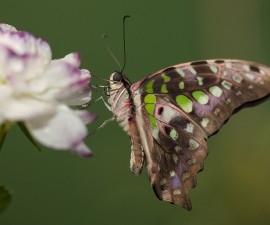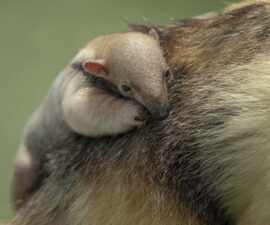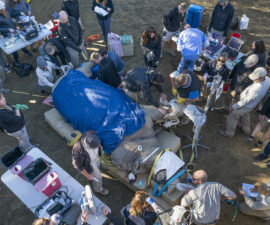Best practices in husbandry and care—plus a trusting relationship with her keepers—put the spotlight on an endangered tree kangaroo and her new joey.
BY Donna Parham
Photography by Ken Bohn and Tammy Spratt
Three-year-old Polly tends to be a bit of an introvert, according to Safari Park mammal keeper Breanne Barney. “She’s shy, but she can also be curious and playful, on her own terms,” says Breanne. “I scratch her back, and she loves it—she leans into it. She has a good relationship with her keepers.” But that trusting relationship between keepers and the Matschie’s tree kangaroo didn’t happen overnight.
“The biggest challenge, when working with a marsupial, is getting them comfortable with us being tactile with them,” says Breanne. She points out that tactile work is something that many animals learn to appreciate. “You see keepers using deck brushes to rub down tapirs, rhinos, and elephants. Such tactile work opens the door for so many more things that help us care for them. We can do blood draws, trim their toenails, eye exams, mouth exams—even finding things like cysts or lesions on their skin.” In fact, keepers have a more hands-on relationship with the tree kangaroos than with many other species, ensuring that they are calm and relaxed as keepers examine parts of their body, including—for females—the pouch.
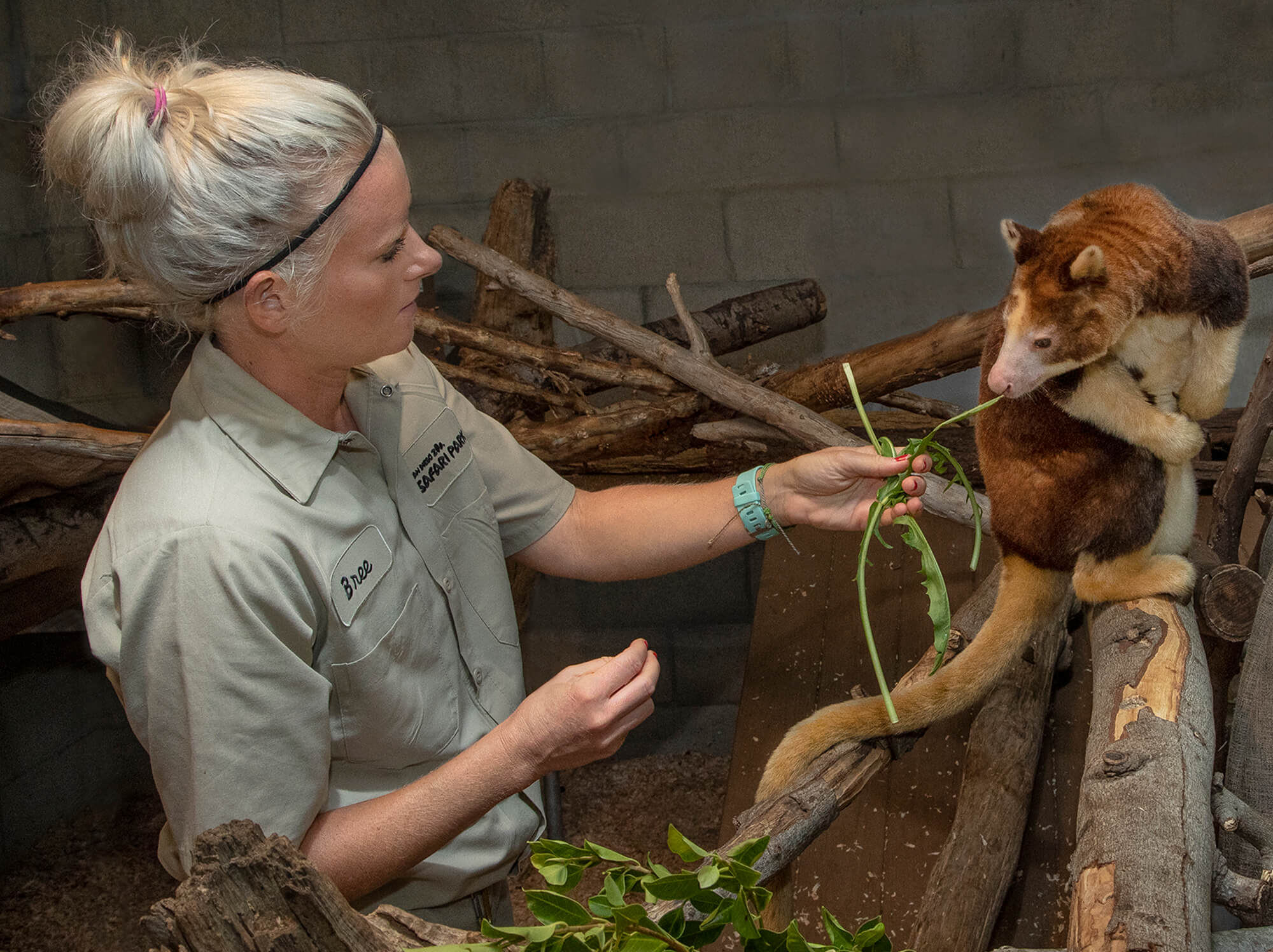
EATING FOR TWO
Tree kangaroos typically browse on a wide variety of plants, including ferns, orchids, impatiens, climbing pandanus, gingers, vines, shrubs, and trees. At the Safari Park, folivore biscuits and fruit complement their diet of veggies and browse.
PRENATAL CARE
Because Polly is an important member of the Association of Zoos and Aquariums’ (AZA) Species Survival Plan (SSP) breeding program for the highly endangered Matschie’s tree kangaroos Dendrolagus matschiei, keepers took tactile training to a new level. They slowly introduced Polly to an endoscope that would provide glimpses of what was happening inside her pouch. Breanne spent long hours desensitizing the tree kangaroo to the instrument. “The endoscope didn’t hurt her at all, but it was probably a little cold, and she didn’t like the color—it’s bright yellow,” says Breanne. (Unlike most other non-primate mammals, kangaroos have color vision.) So, Breanne tucked the endoscope up into her sweatshirt sleeve. “That way it was warm, and she didn’t have to see it. I used touch and food rewards with her, while I gradually fed the endoscope into her pouch.” Breanne continued using baby steps to familiarize the tree kangaroo with the sensation, and then the sight, of the endoscope. “She became absolutely comfortable with it, but it was months of work, building up to that point.”
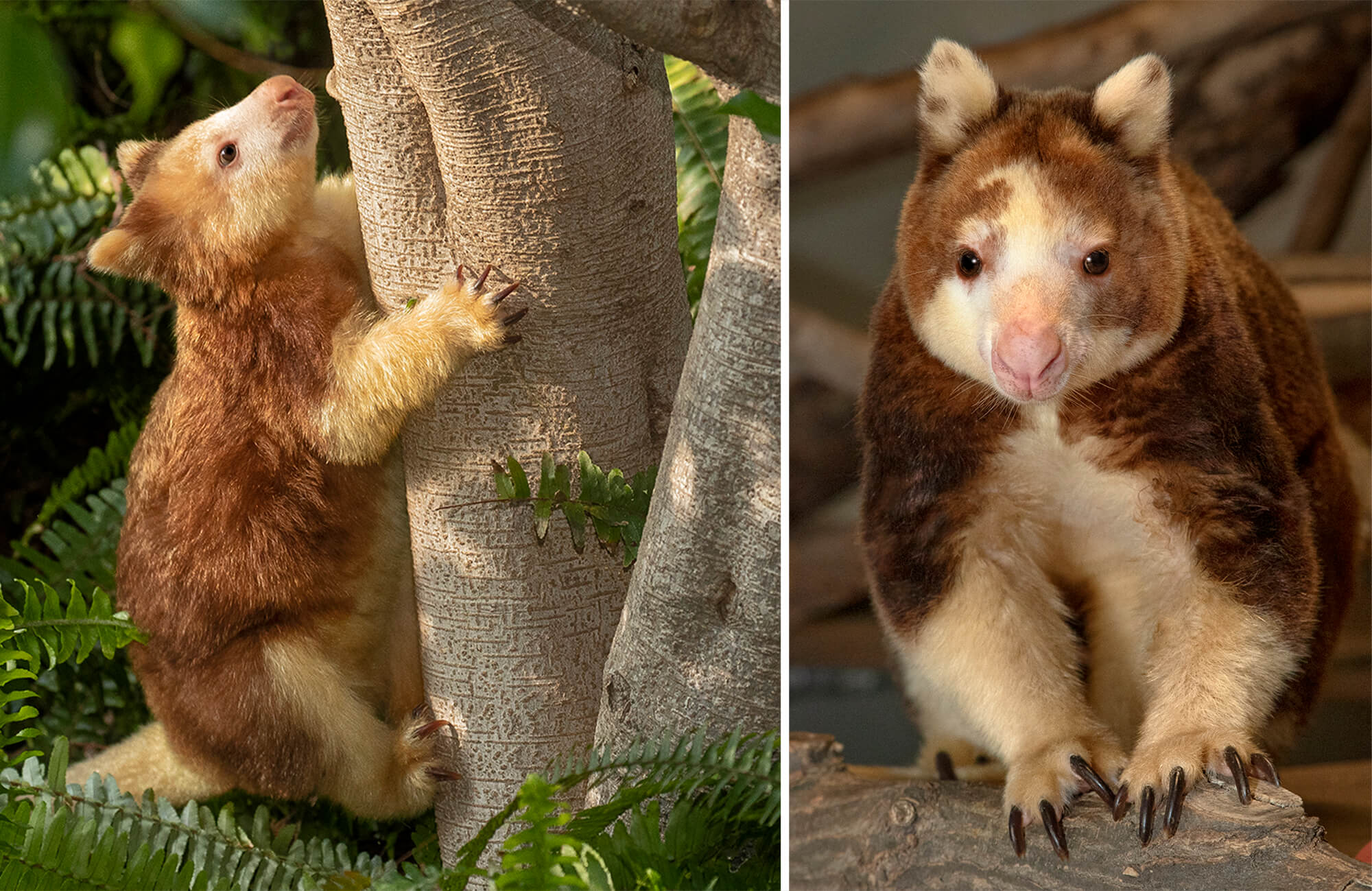
LIVING THE HIGH LIFE
Long, sharp claws help a tree kangaroo climb in trees. Small, knobby projections—similar to those on the face of a ping-pong paddle—add grip to its palms and soles. Compared to ground-dwelling kangaroos, tree kangaroos have shorter hind legs; sturdier forelegs; and shorter, broader feet—adaptations that suit their arboreal lifestyle.
The SSP matched Polly with Spike, a male tree kangaroo Breanne describes as “more of an extrovert.” The first day they introduced the pair, keepers were encouraged to see the beginnings of courtship behavior. The next day, Polly and Spike moved past the getting-to-know-you stage, and keepers reported breeding behavior characteristic for the species. “For the next few days, Polly was doing a lot more pouch and genital region grooming than usual, so we knew that something promising had probably happened.” The waiting began: gestation for tree kangaroos generally lasts about 45 days.
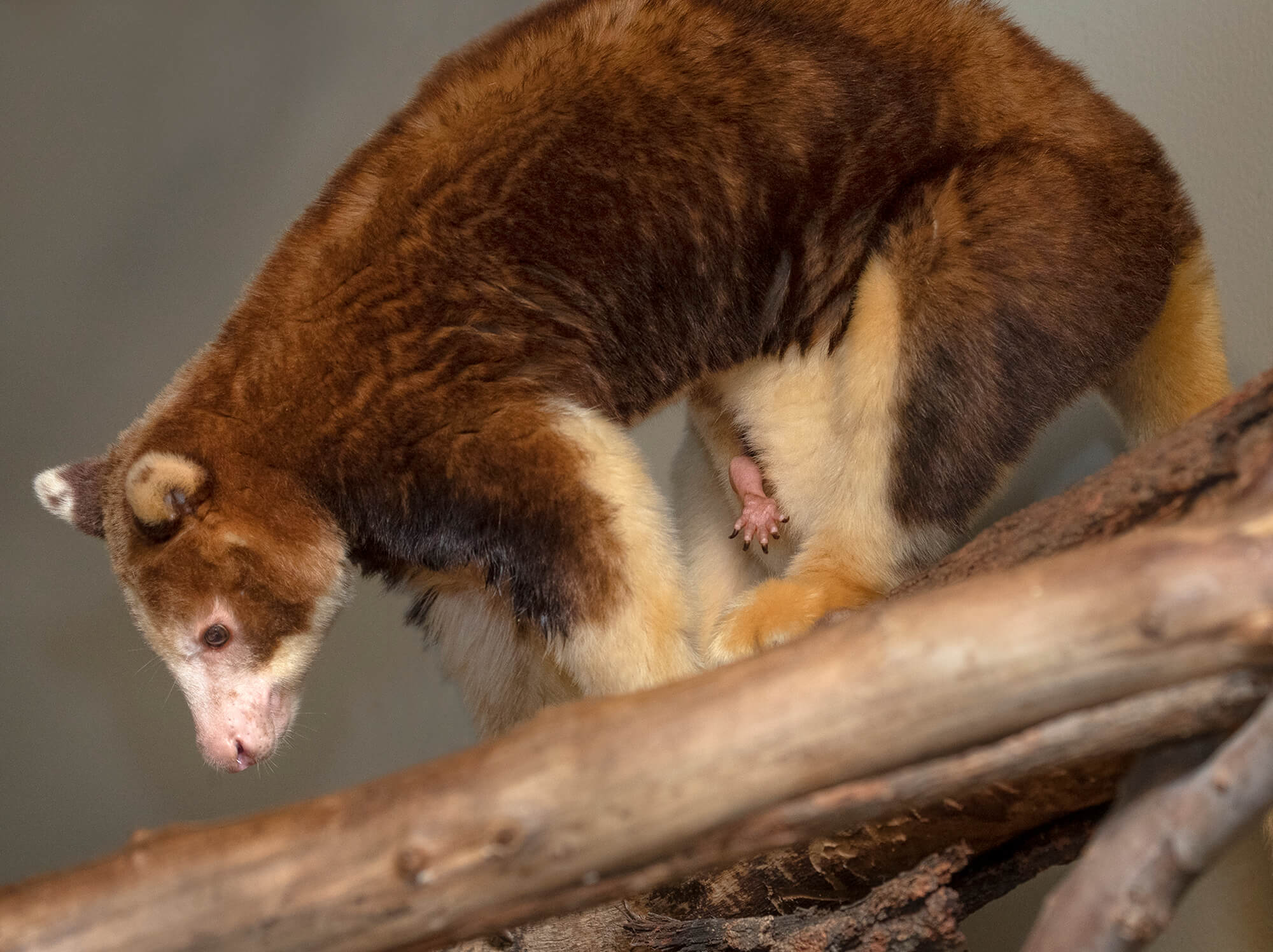
HIGH FIVE
Visitors caught glimpses of the new joey even before it peeked out of the pouch for the first time.
NEWBORN—YET “UNBORN”
A newborn joey must make it safely from the birth canal to its mother’s pouch (unassisted!) and latch onto one of her teats. A joey’s lips actually form a seal around a teat, and it will suckle continuously for the first few months of life. When giving birth, a mother tree kangaroo typically curls into a position that makes it easier for her gummy-bear-sized newborn to make the journey. When, about 45 days after breeding, keepers noticed Polly “kind of hunched into a fetal position, with her tail between her legs,” they were hopeful.
There wouldn’t be external evidence of a joey for nearly five months, however. “You couldn’t even tell there was a joey in her pouch,” says Breanne. In fact, kangaroos and their kin do most of their development after reaching the pouch. A joey’s “birthday” is recorded as the first day it pokes its head out of mom’s pouch—about five months after it’s born. A bit confusing—but when you consider the embryonic stage of development at which these marsupials are born, it makes sense.
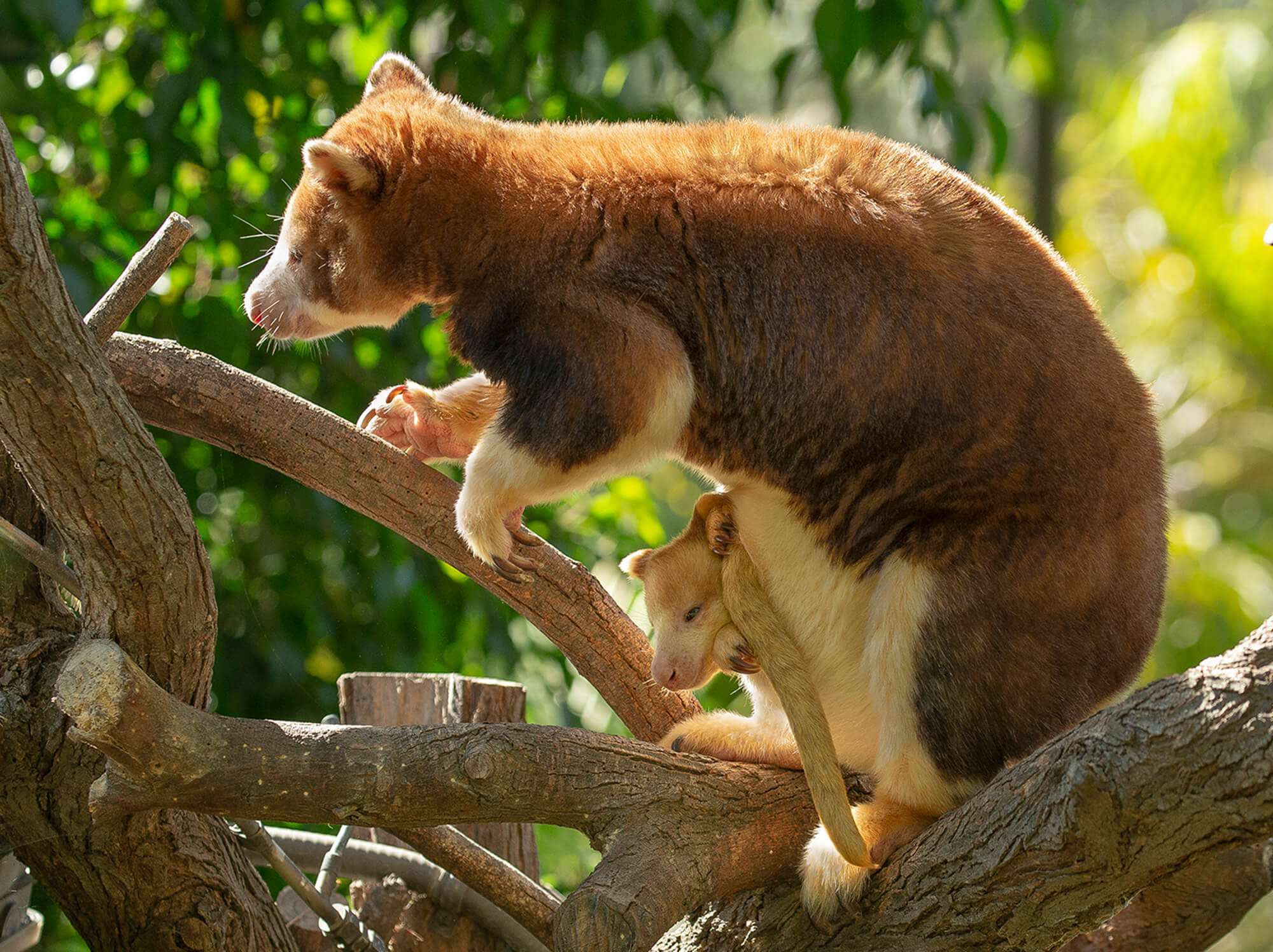
HELLO, WORLD
After nearly five months curled up in Polly’s cozy pouch, little Luka decides it’s time to take a look around.
TAKING CARE
Thanks to her earlier training, Polly was relaxed and calm when, within days of the joey’s arrival, Breanne gently slid the endoscope into her pouch. Keepers were thrilled when a wireless connection to a mobile phone revealed the amazing image of the embryonic joey, securely attached to a teat. They named the new joey Luka, from the Papua New Guinea (PNG) Tok Pisin word “lukuatim,” which means “to take care of” or “to look after.” The name was suggested by the people of PNG’s Huon Peninsula, where the Matschie’s tree kangaroo is an endemic species. “Tree kangaroos mean a lot to those dedicated to saving them in Papua New Guinea, and we chose the joey’s name to reflect our shared work and dedication to saving endangered species around the world,” says Breanne.
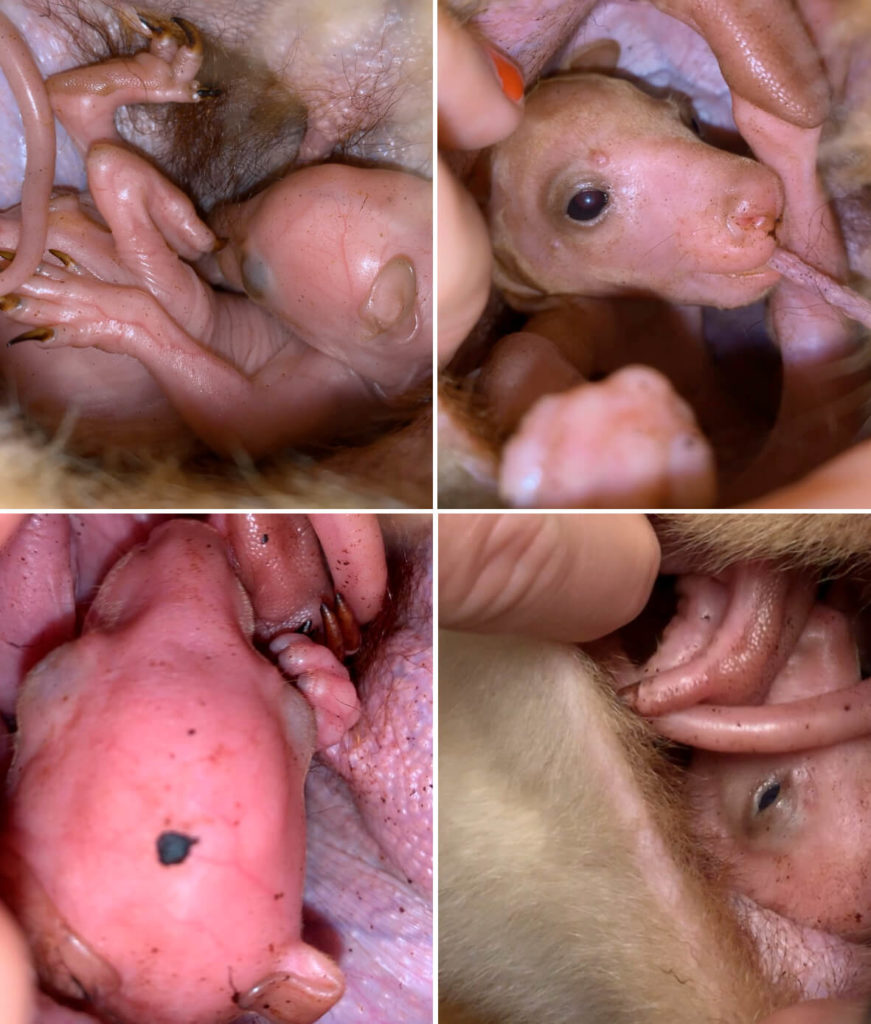
A PEEK INTO POLLY’S POCKET
Breanne spent long hours desensitizing Polly to the endoscope, but her months of hard work paid off when she was able to use the instrument to capture pictures of the embryonic joey.
Using the endoscope, keepers monitored tiny Luka as she developed, long before they started seeing glimpses of her arms, legs, and tail. “We were able to do regular pouch checks, and take pictures and video. That wouldn’t have been possible without Polly’s trust and cooperation,” Breanne says. “It was fascinating to see her reaction. She was very interested, and she’d even watch the image on the phone while I used the endoscope.”
Breanne started training Luka long before the joey left her mom’s pouch. “We gave her a little bit of time to get acclimated; then by middle of September, I started gently touching her feet and hands. By late October, I was also touching her head, ears, and mouth,” says Breanne. “The next stage starts when she is permanently out of the pouch.” A trusting tactile relationship with her keepers will pay off when Luka herself is of breeding age.
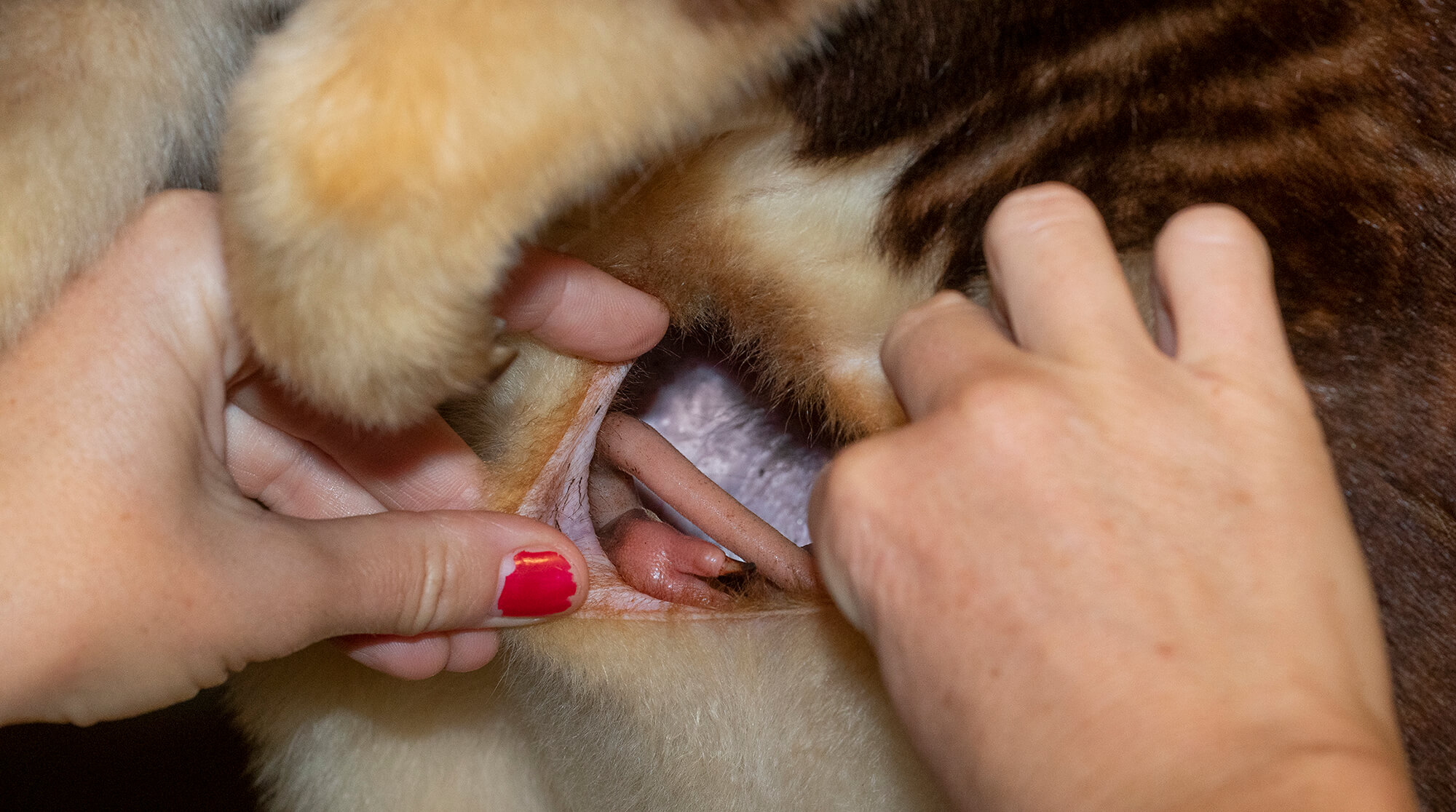
THE BEGINNING OF A BEAUTIFUL RELATIONSHIP
Breanne began building a trusting relationship with Luka even before the little joey opened her eyes. Gentle touches pave the way for more tactile training when Luka leaves the pouch. Tactile training helps keepers provide the best care for the tree kangaroos.
CONSERVATION IN THE FIELD
In their native range on PNG’s Huon Peninsula, Matschie’s tree kangaroos are declining. “Fewer than 2,500 of them remain,” says Breanne. She wants people to know that all tree kangaroo species Dendrolagus are under threat—mostly as a result of an expanding human population, and habitat fragmentation and loss. In PNG, more than 95 percent of land is privately owned, so the cooperation of local people is key to the success of conservation efforts. San Diego Zoo Global supports the Tree Kangaroo Conservation Program (TKCP), the designated field program for the AZA SSP for Matschie’s tree kangaroos. Working in partnership with local landowners toward land use planning, TKCP supports research that contributes to the global scientific knowledge of the wildlife of the Huon Peninsula, while enhancing the livelihood, education, and health of the local community.
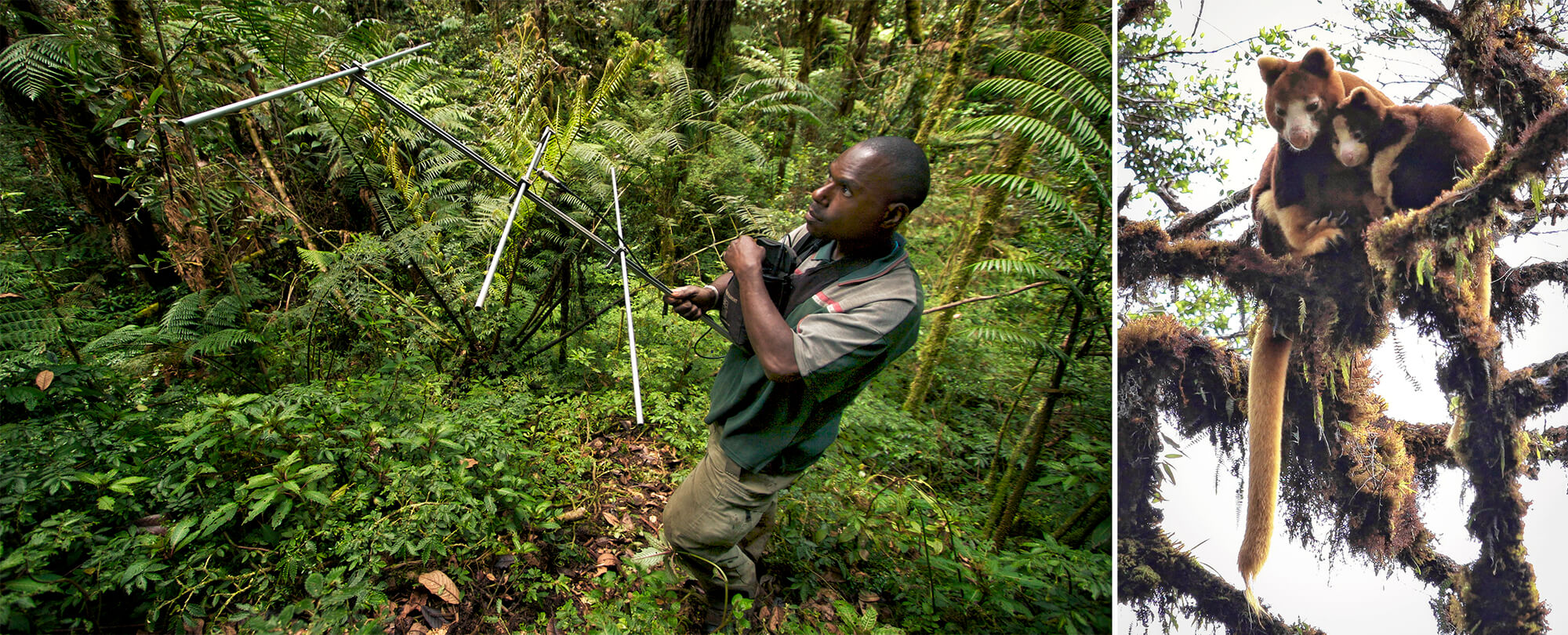
CARING FOR THE RAIN FOREST
In Papua New Guinea, a Tree Kangaroo Conservation Program (TKCP) researcher tracks and monitors wildlife of the Huon Peninsula. All Matschie’s tree kangaroos live in a single population, in high elevations of the Huon Peninsula. The TKCP partners with local landowners to safeguard the species and other wildlife in the region. (Photos by: (Left) Tree Kangaroo Conservation Program, Woodland Park Zoo; (Right) Russ Mittermeier)
“Tree kangaroos are a priority species,” explains Breanne. “If you see them disappear, there are other species—like the orchids they eat, bees, birds, frogs, insects—that are disappearing, too. It’s a chain, and once a piece is gone, it falls apart. Getting that information out is vital.” She thinks tree kangaroos are uniquely able to help share that message. “They’re cute and fuzzy, and they look like stuffed animals”—something that encourages people to care about them and their survival.


